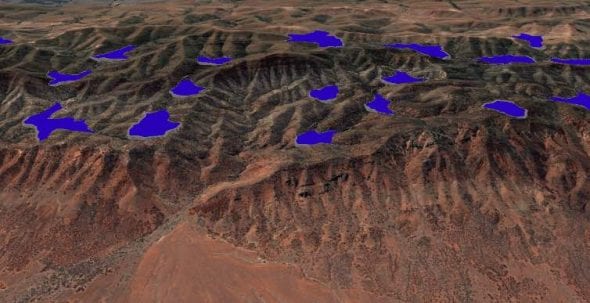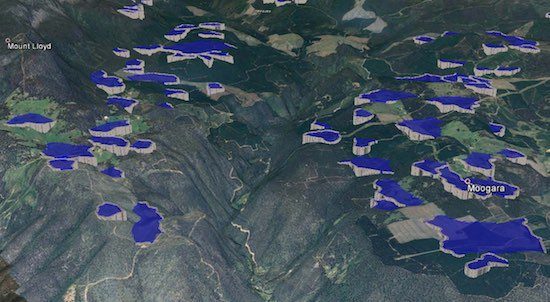4th August 2017
Australia has enough untapped pumped hydro energy storage potential to support a 100 per cent renewable energy grid – 35 times over, a team of Australian National University researchers has found.
The ANU team – led by one of Australia’s key solar PV innovators, Professor Andrew Blakers – said this week it has so far mapped roughly 5,000 potential pumped hydro energy storage sites around the country, and hopes to identify hundreds more, as part of an ARENA funded study.

Potential PHES upper reservoir sites east of Port Augusta, South Australia. The lower reservoirs would be at the western foot of the hills (bottom of the image)
Professor Blakers said the energy storage potential of the sites already identified ranged from 0.9GWh to more than 100 gigawatt-hours (GWh); far eclipsing the capacity of the lithium-ion “Big Battery” Tesla is currently building in South Australia.
In total, the sites charted by the team – across Queensland, Tasmania, the Canberra district and in and around Alice Springs – are believed to have a combined energy storage potential of 15,000 gigawatt-hours, which Blakers says is 35 times larger the capacity required to support a 100 per cent renewable grid.
“Each site has seven to 1,000 times larger storage potential than the 0.13 GWh Tesla battery to be installed in South Australia,” said Blakers.
“Additionally, pumped hydro has a lifetime of 50 years compared with eight to 15 years for batteries.”
The ANU-led study, which has received $449,000 in funding from the Australian Renewable Energy Agency, aims to develop a nation-wide atlas of potential off-river pumped hydro storage sites, as part of the broader quest to accommodate higher and higher levels of variable solar and wind energy generation on the National Electricity Market.
Queensland has shown particular promise, with 2,213 potential sites identified, with a combined energy storage capacity of about 100 times more than would be required to support a 100 per cent renewable electricity system in the state, the report says.
Tasmania is similarly well endowed, with 2017 potential sites identified by the research.
“Tasmania already has large water storages, several of which are suitable for pumped hydro energy storage,” the report says. “The large number of upper storage sites identified in this
work provides confidence that there will be a sufficient number of feasible PHES for very large-scale storage.”
Off-river pumped hydro works by storing water in an upper reservoir and running it through a turbine to a lower reservoir when electricity is needed – such as when the sun is not shining or the wind is not blowing. The water can then be pumped back uphill when electricity from renewables and other sources is abundant and cheaper.
And while this well and truly mature technology currently accounts for a massive 97 per cent of energy storage capacity worldwide, it has fairly specific geographical requirements.
This includes pairs of reservoirs, typically ranging from 10 to 100 hectares, separated by an altitude difference of at least 300 metres, and joined by a pipe with a pump and turbine.
So far, there are not many large-scale pumped hydro energy storage systems operating in Australia – although NSW-based company, Genex Power, has been working away at its plans to convert the abandoned Queensland Kidston goldmine into one of Australia’s largest new examples, paired with a solar array.
Nonetheless, Blakers says his team’s work has revealed thousands of sites in Australia that “may be suitable” for establishing pumped hydro storage.
“All the potential sites we have found are outside national parks and urban areas, and like all hydro power can go from zero to full power very quickly,” he said.
“This assessment is based on very appealing physical characteristics. But the potential upper reservoir sites identified would require detailed due diligence involving land ownership, engineering, hydrological, environmental and other considerations.”
ANU co-researcher Matthew Stocks said the pumped hydro storage that could be built on the sites identified by the team could be capable of delivering maximum power from hours to more than a day.
“Our earlier work demonstrated the feasibility of 100 per cent renewable electricity for Australia supported by pumped hydro storage,” said Dr Stocks from the ANU Research School of Engineering.
“About 3,600 hectares of reservoir is required to support a 100 per cent renewable energy grid for Australia, which is five parts per million of Australia’s land mass. Annual water requirements would be less than one per cent of annual extraction from the Murray River.”
ARENA CEO Ivor Frischknecht said the project was part of ARENA’s focus on supporting flexible capacity solutions to ensure a smooth transition to a renewable energy future.
“Storage is becoming more important and valuable as we move towards higher levels of renewable energy in our grids,” he said.
“Pumped hydro is the most mature form of energy storage, and studies like these are helping to determine whether it could play an even greater role in increasing grid stability.”
ANU is partnering with ElectraNet and VTara Energy Group to conduct the Atlas of Pumped Hydro Energy Storage Study and develop a cost model for short-term off-river pumped hydro energy storage.
Further site searching is underway in NSW, Victoria, Western Australia and the Northern Territory, and is expected to “add greatly” to the total capacity already identified.


